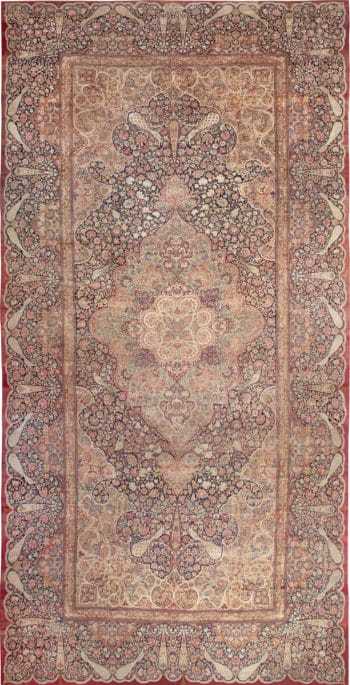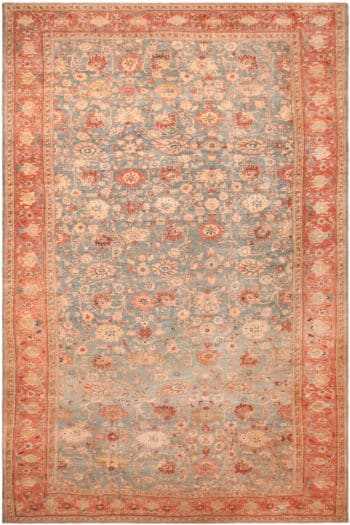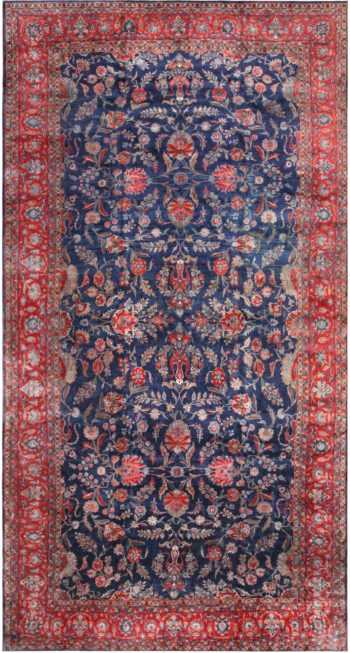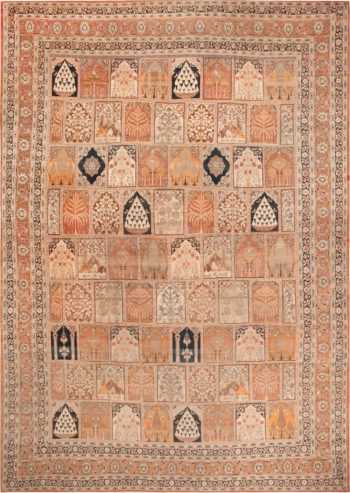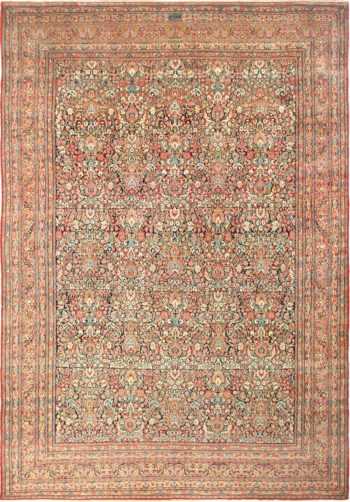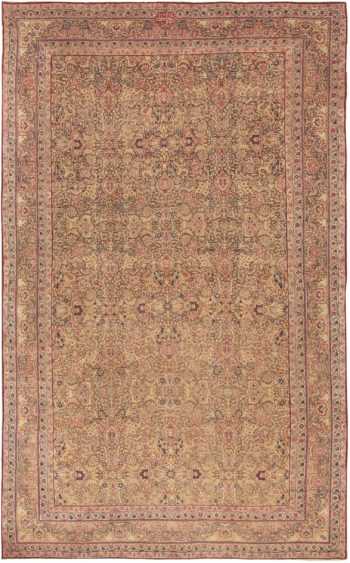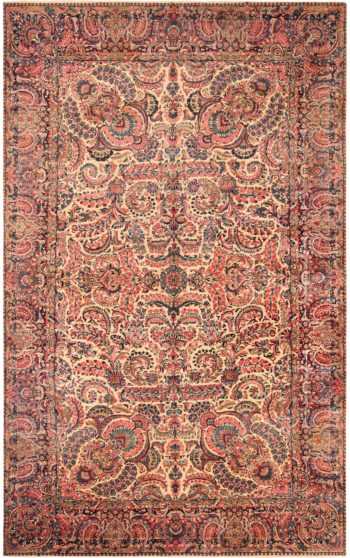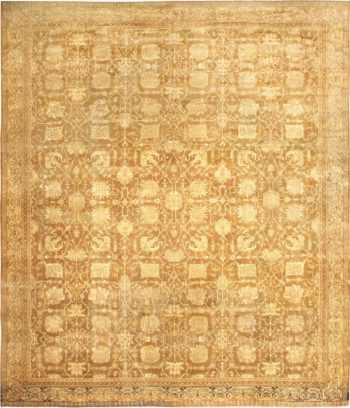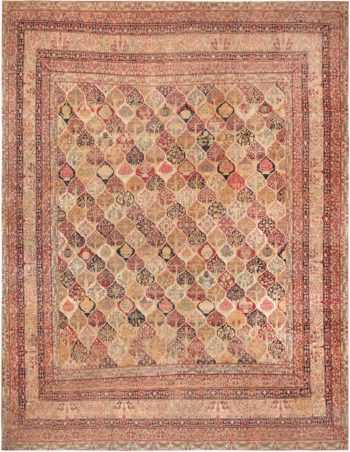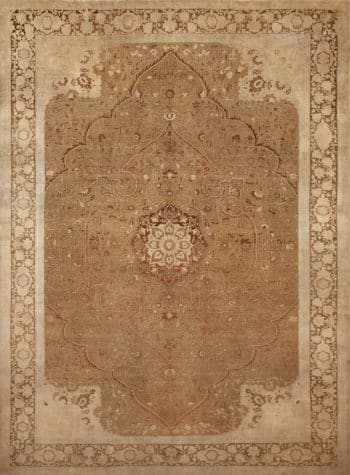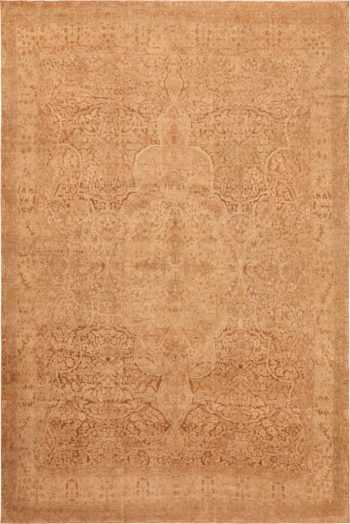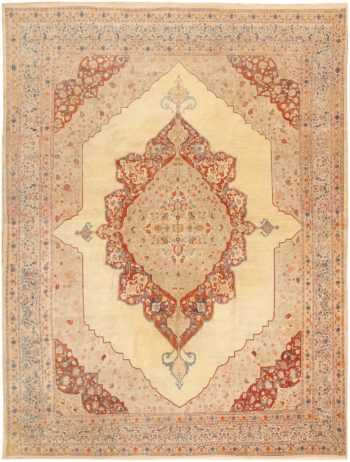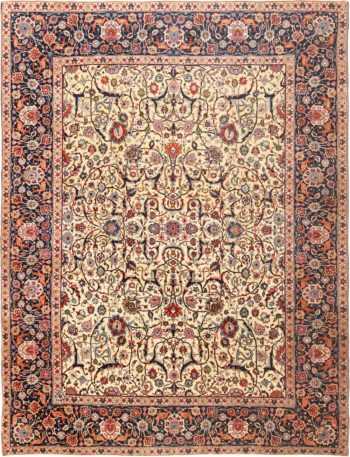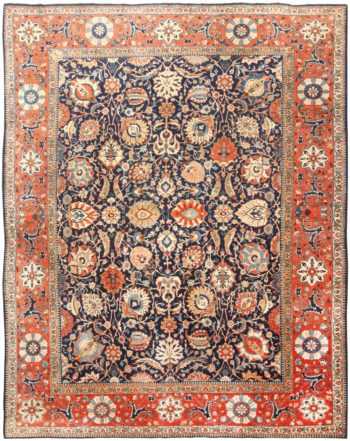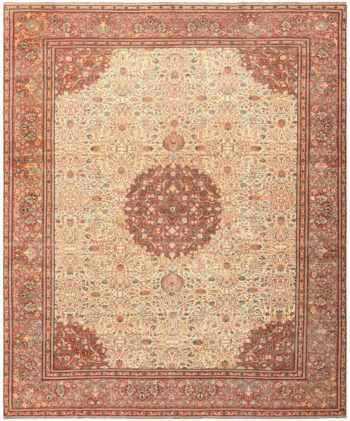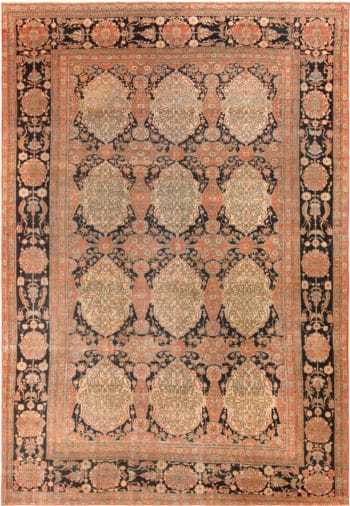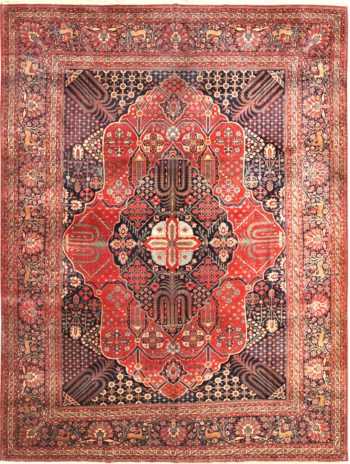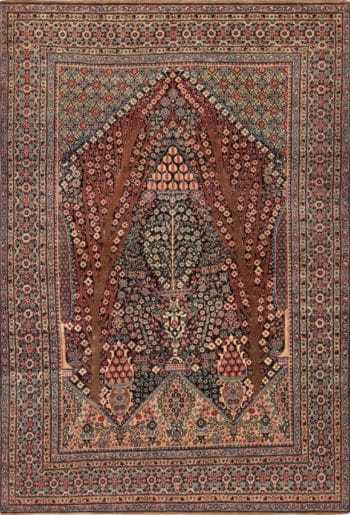Traditional Rugs
Just getting you started with some traditional rugs from our collection:
-
Fine Oversized Floral Animal Design Antique Persian Kerman Rug 72499
$88,000.00Size: 14 ft 3 in x 29 ft 8 in (4.34 m x 9.04 m) -
Fine Floral Animal Design Antique Oversized Persian Tabriz Rug 72518
$89,000.00Size: 17 ft x 24 ft 7 in (5.18 m x 7.49 m) -
Beautiful Classic Light Blue Oversized Antique Persian Sultanabad Rug 72205
$86,000.00Size: 14 ft 9 in x 23 ft 6 in (4.5 m x 7.16 m) -
Luxurious Fine Oversized Antique Persian Traditional Kashan Manchester Wool Rug 72080
$39,000.00Size: 11 ft x 20 ft 8 in (3.35 m x 6.3 m) -
Fine Beautiful Large Antique Persian Haji Jalili Tabriz Garden Design Rug 72070
$135,000.00Size: 14 ft 6 in x 20 ft (4.42 m x 6.1 m) -
Large Blue Background Classic Traditional Floral Design Antique Persian Khorassan Rug 49517
$32,000.00Size: 13 ft 3 in x 19 ft 2 in (4.04 m x 5.84 m) -
Large Antique Light Brown Background Kerman Persian Rug 44491
$42,000.00Size: 11 ft 6 in x 17 ft 9 in (3.51 m x 5.41 m) -
Beautiful Elegant Large Vintage Classic Renaissance Savonnerie Style Rug 71970
$26,500.00Size: 14 ft 4 in x 17 ft 8 in (4.37 m x 5.38 m) -
Large Antique Persian Kerman Floral Millefleur Rug 71778
$18,500.00Size: 10 ft 9 in x 17 ft 6 in (3.28 m x 5.33 m) -
Large Antique Vase Design Indian Amritsar Rug 50341
$44,000.00Size: 14 ft 8 in x 17 ft 5 in (4.47 m x 5.31 m) -
Beautiful Large Fine Garden Design Antique Luxurious Persian Kerman Rug 72038
$38,500.00Size: 13 ft 2 in x 17 ft (4.01 m x 5.18 m) -
Rustic Fine Large Antique Persian Kashan Mohtashem Rug 72479
Size: 10 ft 4 in x 15 ft 8 in (3.15 m x 4.78 m) -
Rare Wool And Cotton Soft Color Fine Weave Antique Persian Tabriz Rug 72428
$145,000.00Size: 10 ft 9 in x 14 ft 5 in (3.28 m x 4.39 m) -
Beautiful Fine Neutral Earthy Traditional Antique Decorative Persian Kerman Rug 71972
$34,500.00Size: 9 ft 7 in x 14 ft 2 in (2.92 m x 4.32 m) -
Fine Classic Traditional Floral Antique Persian Haji Jalili Tabriz Medallion Rug 47135
Size: 10 ft x 13 ft 9 in (3.05 m x 4.19 m) -
Beautiful Antique Traditional Classic Ivory Room Size Fine Persian Tabriz Area Rug 49064
$16,500.00Size: 9 ft 4 in x 12 ft 6 in (2.84 m x 3.81 m) -
Fine Antique Persian Medallion Kerman Room Size Rug 46655
Size: 9 ft x 12 ft 4 in (2.74 m x 3.76 m) -
Blue Antique Room Size Persian Vase Design Tabriz Rug 47064
$24,000.00Size: 9 ft 6 in x 12 ft (2.9 m x 3.66 m) -
Beautiful Fine and Intricate Antique Persian Medallion Tabriz Carpet 50312
Size: 9 ft 6 in x 11 ft 6 in (2.9 m x 3.51 m) -
Rare Luxurious Fine Antique Persian Mohtasham Kashan Area Rug 72096
$125,000.00Size: 8 ft 9 in x 11 ft 2 in (2.67 m x 3.4 m) -
Antique Electric Light Blue Color Persian Sultanabad Room Size Area Rug 48725
$22,000.00Size: 8 ft 10 in x 11 ft 2 in (2.69 m x 3.4 m) -
Antique Persian Mohtashem Kashan Rug 72478
$26,000.00Size: 7 ft 2 in x 10 ft 6 in (2.18 m x 3.2 m) -
Fine Jewel Tone Color Antique Classic Traditional Persian Medallion Design Mohtasham Kashan Area Rug 71617
$76,000.00Size: 7 ft 7 in x 10 ft (2.31 m x 3.05 m) -
Fine Floral Antique Persian Prayer Design Tehran Rug 72456
Size: 4 ft 8 in x 6 ft 10 in (1.42 m x 2.08 m)
Traditional Rugs Offer Endless Possibilities for Traditional Interior Design
What is a traditional area rug?
A traditional rug typically refers to a floor covering that is made using traditional weaving or knotting techniques, often passed down through generations within a particular culture or region. These rugs are characterized by intricate patterns, designs, and craftsmanship that reflect the artistic and cultural heritage of the community where they are produced.
Traditional rugs can be made from various materials such as wool, silk, or cotton, and they come in a variety of styles, colors, and sizes. Each region or culture may have its own distinct patterns and motifs, making traditional rugs a unique and culturally significant form of art and craftsmanship.
What are some of the more traditional rug designs and patters?
Traditional rugs exhibit a wide range of designs and patterns, often influenced by the cultural, historical, and artistic traditions of the region where they are produced.
Here are some examples of traditional rug designs and patterns from various cultures:
- Persian Rugs:
- Medallion and Corner: Central medallion surrounded by intricate designs and corner motifs.
- Floral Motifs: Elaborate floral patterns, including roses, lilies, and other botanical elements.
- Geometric Patterns: Geometric shapes and motifs like hexagons, diamonds, and stars.
- Oriental Rugs:
- Geometric Medallion: Central medallion with geometric patterns and borders.
- Paisley or Boteh Motifs: Distinctive droplet-shaped motifs often resembling a twisted tear or seed.
- Turkish Rugs:
- Guls: Circular or octagonal medallions with geometric patterns, commonly arranged in rows.
- Prayer Rugs: Include an arch or mihrab design, symbolizing the direction of Mecca for Islamic prayers.
- Moroccan Rugs:
- Berber Designs: Often feature abstract geometric patterns and symbols.
- Diamonds and Lines: Simple yet bold diamond shapes and straight lines.
- Kilim Rugs:
- Flatweave: Kilims are flat-woven rugs with no pile, featuring geometric patterns and bold colors.
- Navajo Rugs:
- Tribal Designs: Geometric patterns, including diamonds, crosses, and stripes.
- Earth Tones: Natural colors such as red, brown, and beige.
- Chinese Rugs:
- Floral and Animal Motifs: Traditional Chinese designs may include flowers, birds, and animals.
- Dragon Patterns: Symbolic dragon motifs representing power and good fortune.
- Indian Rugs:
- Mughal Designs: Floral patterns and intricate details inspired by Mughal art.
- Paisley and Boteh Motifs: Commonly used in Indian rug designs.
These are just a few examples, and each region or culture has its own unique rug traditions with specific patterns and symbols that hold cultural significance.
Why do people look for traditional area rugs specifically?
People often seek traditional area rugs for various reasons.
The choice to opt for traditional designs is influenced by several factors:
- Cultural and Artistic Appeal: Traditional rugs are often considered works of art, reflecting the cultural heritage and artistic traditions of a particular region. The intricate patterns and designs tell a story and add a sense of history and authenticity to a space.
- Timeless Aesthetic: Traditional rug designs have stood the test of time. Their timeless beauty and classic patterns make them versatile, allowing them to complement various interior styles and decor. They can be a focal point in a room or blend seamlessly with different design elements.
- Craftsmanship and Quality: Traditional rugs are typically crafted using traditional weaving or knotting techniques that have been passed down through generations. The attention to detail and craftsmanship involved in creating these rugs often results in high-quality, durable products.
- Symbolism and Meaning: Many traditional rug designs carry symbolic meanings. For example, certain motifs may represent protection, good luck, or religious beliefs. People may choose rugs with specific symbols that hold personal or cultural significance.
- Connection to Heritage: Individuals with a cultural or familial connection to a particular region may choose traditional rugs as a way to honor and celebrate their heritage. These rugs can serve as a tangible link to ancestral traditions and customs.
- Collector’s Items: Some people are avid collectors of traditional rugs as part of their appreciation for cultural artifacts and craftsmanship. Antique or vintage traditional rugs, in particular, can be sought after by collectors.
- Warmth and Comfort: Traditional rugs, especially those with a thick pile, provide a sense of warmth and comfort underfoot. This can make a space feel more inviting and cozy.
- Unique and Handmade: Traditional rugs are often handmade, adding a sense of uniqueness to each piece. The imperfections and variations in handmade rugs contribute to their charm and individuality.
- Investment: High-quality traditional rugs, especially antique or rare pieces, can appreciate in value over time. Some individuals view traditional rugs as not only decorative elements but also as potential investments.
In summary, the appeal of traditional area rugs lies in their cultural richness, timeless beauty, craftsmanship, and the personal connections they can evoke. Whether for aesthetic reasons, cultural significance, or a combination of factors, traditional rugs continue to be sought after in the world of interior design and decor.
How do people decorate around a traditional area rug?
Decorating around a traditional area rug involves creating a cohesive and harmonious look that complements the rug’s design while enhancing the overall aesthetic of the space.
Here are some tips on how people typically decorate around traditional area rugs:
- Choose a Central Color Palette: Select colors from the rug’s design to establish a cohesive color palette for the room. This helps create a unified look and ties the elements together.
- Coordinate Furniture Colors: Ensure that the colors of furniture in the room complement or coordinate with the dominant hues in the rug. This creates a balanced and visually pleasing arrangement.
- Balance Patterns: If the rug has intricate patterns, balance it with simpler or solid-colored furniture upholstery. This prevents the room from feeling too busy and allows the rug to stand out.
- Size and Placement: Ensure that the rug is appropriately sized for the room. Ideally, all furniture legs should sit on the rug or at least the front legs. This creates a sense of cohesion and defines the seating area.
- Layering with Furniture: Layering smaller traditional rugs on top of a larger one can add visual interest. However, this requires careful consideration of patterns and colors to avoid a clash.
- Consider Wall Colors: Take into account the wall colors when decorating around a traditional rug. The walls can either complement or contrast with the rug, depending on the desired effect.
- Accessorize with Complementary Elements: Use accessories such as throw pillows, curtains, and artwork that echo the colors and motifs of the rug. This reinforces the design scheme throughout the room.
- Mix Textures: Introduce various textures in the room to add depth and dimension. This could include textured fabrics, wood finishes, and metal accents that complement the traditional rug.
Pay Attention to Lighting: - Adequate lighting can enhance the beauty of the rug. Consider using lighting fixtures that highlight the rug and contribute to the overall ambiance of the space.
- Create a Focal Point: Allow the traditional rug to serve as a focal point in the room. Arrange furniture and other elements to draw attention to the rug and showcase its intricate patterns.
- Blend Modern and Traditional Elements: For a contemporary twist, mix traditional rugs with modern or eclectic furniture pieces. This juxtaposition can create a visually interesting and dynamic look.
- Maintain Balance: Strive for a balanced distribution of colors, patterns, and textures throughout the room to ensure a visually pleasing and harmonious atmosphere.
Ultimately, the key is to be mindful of the traditional rug’s design and use it as a foundation for creating a well-coordinated and inviting living space. Experiment with different elements until you achieve a look that complements both the rug and your personal style.
More about traditional area rugs:
There is no denying the beauty of traditional rugs and their ability to add character to the room. A fine weave rug is an investment that you will probably be living with for quite a long time, so it is important to choose the perfect rug for your room. If your style is traditional, choosing the right rug is essential to tie the room together.
Choosing a rug is a big decorating decision. You need to find one that will help you create the look you want plus you really need to love it. As you embark on your quest for the perfect carpet, there are some things that you need to know about adding a rug to traditional and classic decor styles.

Antique Persian Traditional Rugs
4 Reasons to Consider Adding A Traditional Rug
Traditional rugs offer versatility and can help achieve practical goals
First off, you can add a traditional rug to pretty much any room design. Even if the room is carpeted, you can layer rugs to help to define the space. A beautiful area rug can also serve as noise control and can prevent echo in a large space. Carpets and rugs also give the appearance of depth to a room, even in rooms that are already carpeted. Of course, they add texture to hardwood floors as well.

Traditional Dining Room Interior With Persian Rug
Traditional rugs Can help Define the Space
Secondly, a rug can help to define your space. You can use traditional Persian rugs to draw attention to showpiece furniture or to create a cozy area for conversation. They can also be used to unify your decor. This is especially true when unifying different color schemes. If the colors in a room just do not seem to come together, the perfect traditional rug can be the piece that brings it all together and makes it look well dressed.
Add Scale With A Traditional Rug
The third reason to consider adding a traditional rug to your room is that it can make a small room feel larger or bring down the scale of an expansive space to make it a little cozier. Historically, this is one of the reasons why people were drawn to Oriental rugs. They were used in the palaces of Persian Sultans to fill expansive spaces. A large size rug , especially when the scale of the design is big as well, has a tendency to make a room feel larger.
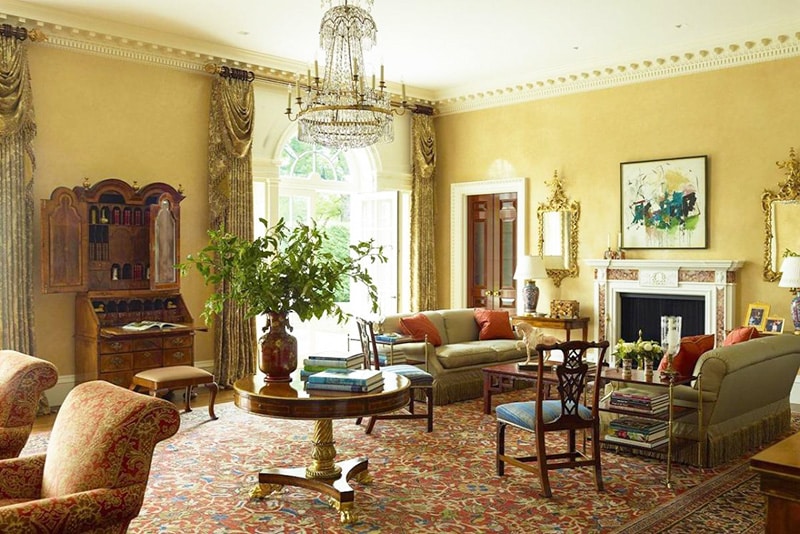
Traditional Living Room With Antique Persian Sultanabad Rug
They would line the floors and walls of palaces with large palatial rugs to make them feel even larger and inspire a sense of awe in the visitor. It gave the space a feeling of connection with the divine by making the architecture appear to be larger than life.
Traditional Rugs Offer An Easy Way to Change It Up
The fourth reason to consider a traditional carpet is that every so often everyone needs a change. Adding a classic rug is a great way to change the feeling of the room and make it feel fresh again. You can add an antique rug and switch out a few accessories for a completely different look.
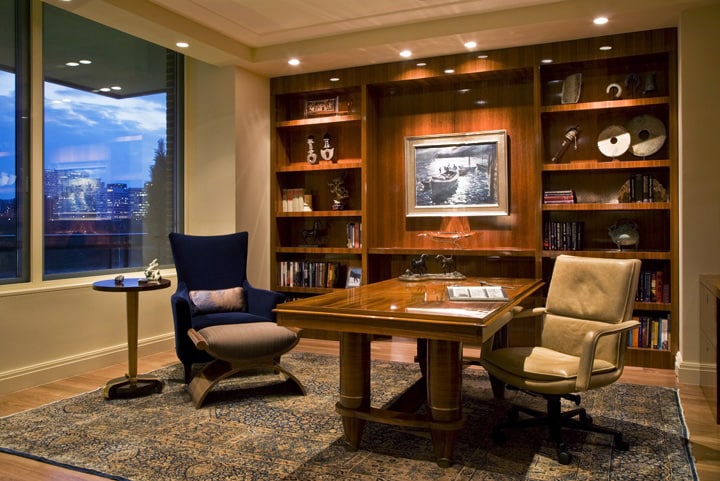
Traditional Persian Rug in Traditional Office Interior
Now you know the reasons to add a traditional rug to your room. Let’s take a look at how to choose the right one.
What is a traditional style rug?
When people think of traditional rugs, they think of the classic types of carpets like Persian or Oriental rugs. They are often finely woven rugs with ornate patterns and a high level of detail. If your furniture includes relief carvings, complex floral fabrics and /or cabriole legs, a traditional designed rug will look right at home.

Traditional Rug in Traditional Dining Room Interior
Traditional style is often rooted in the 18th century and 19th century. It often has English or French court influences or perhaps embodies French country charm. Traditional style can feel formal and elegant, or it can be a bit more rustic.
Consider The Borders Of The Traditional Style Rugs
The border of the rug is an important part of the design when choosing the right rug for the space. Traditional Persian rugs often have multiple borders that consist of a main border and guard borders. Generally speaking, the higher the number of borders, the more formal the design will look.

Rug Borders
In addition, the borders of the rug take up different proportions of space as compared to the field. The wider the border and the more complex, the more it compliments ornate furniture. In a smaller room, a rug with wider borders may make the room look even smaller, but this can work well if you are trying to make an expansive space look more intimate. Think about the borders and how they will add scale to the room when choosing a rug.
What About Traditional Colors?
One of the most beautiful characteristics of rugs is the color combinations. The antique rugs were often created with a different sense of color coordination than we see today. They often used high contrast and bold colors. Many times, the colors used in Persian rugs were dependent on the type of carpet dye stuff that was available. This means that in some cases, one can find a Persian rug that has an unusual color combination that you normally would not think of using modern color theory.
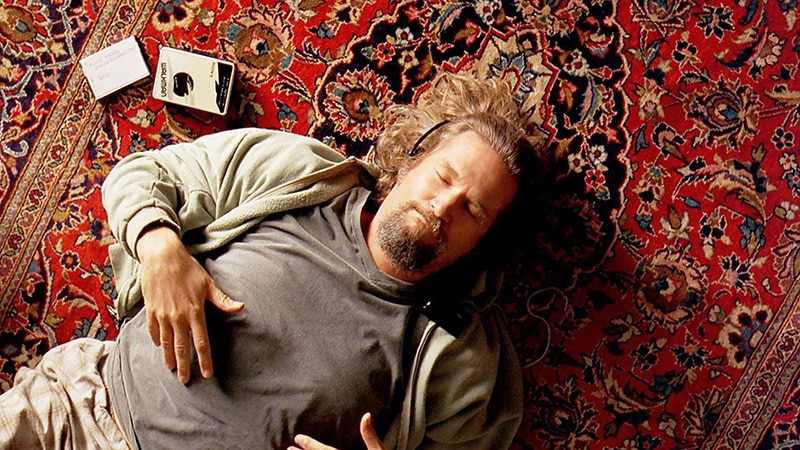
Big Lebowski Chilling On A Traditional Rug
This can be a designer’s dream, as it allows them to step outside of the box when it comes to putting together interior design color combinations. They can either choose a color that will blend with the rest of room, or they can choose a piece that will add a spectacular point of interest. Persian carpets offer an endless variety of color combinations. Some of them are bold and vibrant, while others are more subdued, as one finds in carpets from Khorassan or China.
Tribal rugs are known for defying the modern sensibilities of color combinations and one can find some truly beautiful examples that cannot be found anywhere else. It may be noted that color is also a characteristic that can add value to the rug as an investment piece. Colors that are in unusual combinations can be more valuable than ones that use more traditional combinations.
What about traditional design?
There are almost endless designs available in Persian carpets. You can find a range from other rug weaving origins of florals, geometry and some that have a decidedly modern contemporary rug appearance but are actually traditional designs. An excellent example is the Moroccan rugs of the Beni Ourain. For traditional room interiors that use the 18th and 19th centuries as design inspiration, you can find authentic antique rugs from that period to match the style of the room.
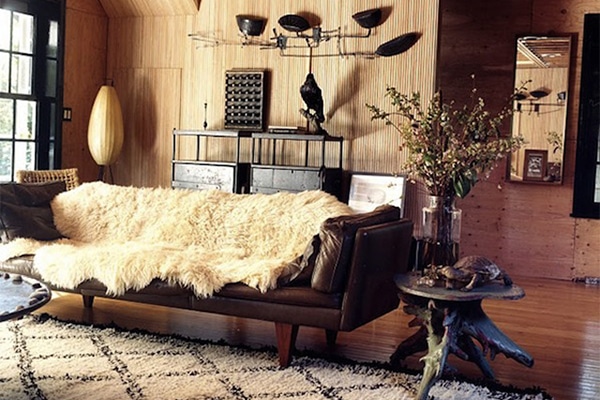
Decorate with Moroccan rugs for a traditional look
Some of the most popular choices for traditional designs are vase rugs, garden design rugs, and other designs that reflect a connection to the natural world and feature garden settings. These rugs can look stunning in a room of rich hardwoods, Louis the XIV, or Victorian furniture choices. However, you can also find a selection of geometric rugs that may be appropriate for simpler lines in furniture and accessories.
Final Considerations Before You Shop For Traditional Style Rugs
Persian rugs make an excellent choice for traditional decor, and this is one of the more popular ways to use them. Before you embark on your rug buying journey, you need to consider a few things aside from the interior design.

Beautiful Interior With Antique Traditional Rug
Condition, for example, plays a role in the value of a rug, but it also plays a role in the look of the room. Shabby chic rugs that show their age can be an excellent addition to traditional decor. They have a timeless rustic quality that shows years of love and service. If you are searching for a more formal look, then you may wish to choose a rug that has shown a little less wear. But naturally, it is all up to you and your style.
The beautiful part about the world of traditional rugs is that there are so many choices. The hardest part may be making the final choice.
Learning About The Magnificent Antique Classic Traditional Rugs
There is nothing that can rival the beauty of classic traditional rugs. The incredible detail and expert craftsmanship showcase the rich history of the ancient craft. The designs themselves flow across the rugs and draw your eye to the complex motif and bold colors. Many of the great master rug weavers worked entirely from memory, weaving rugs as a valuable record of family or tribal traditions and even marking world events or iconic locations.
Exploring The Beauty Of Antique Classic Traditional Rugs
While the term “traditional” and “classic” are not origin specific, we will focus on talking about the rugs woven in Persia. This is because few locations will have the depth and variety of rugs and carpets that the Persian productions have. Also, few rug weaving countries can compare to the beauty and style found within traditional rugs. These ancient elegant and artistic rugs are unique to modern day Iran as well as the surrounding areas that once belonged to the Persian empire. As such, they feature a number of traditional and classic rug design motifs and patterns. In addition, many of these rugs showcase the rug history of the Persian empire as well.
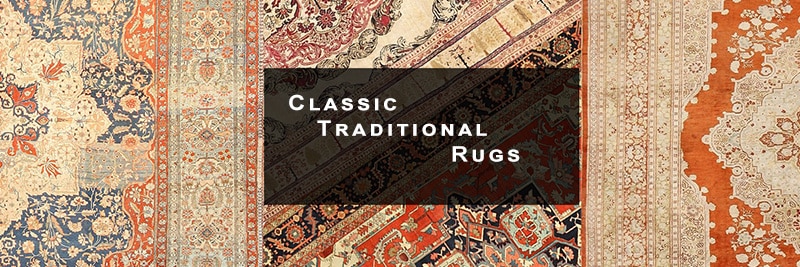
Antique Classic Traditional Rugs
These classic traditional rugs stand out in particular because of their craftsmanship and the pride that the rug weavers had for their craft. Artists focus on establishing complicated motifs and patterns that define the style, crafting manifold designs that often use fine, thin lines to direct motion and draw the viewer’s attention from one section of the rug to the next. Many rugs come from areas that feature traditional and time honored classic designs, particularly those that center around previous nomad tribes.
In these communities, the rug weaver is typically able to work on the rug from memory, crafting patterns that are specific to their family or to a certain tribal tradition. These classic rugs are highly valued because of what they represent, as the artist combines masterful weaving techniques with extraordinary colors and designs. For more complicated intricate and refined patterns, it is not uncommon for artists to first sketch out their rendition before applying their vision to the textiles themselves, working painstakingly by hand to establish careful and meticulously thought out details.
One of the most beautiful motifs present through many traditional rugs is the presence of classic all-over designs that span the entirety of the rug’s core. One single basic design is often chosen and repeated in a series of patterns across the field. These traditional rug patterns are not created with the borders in mind, and once the spacing limit has been reached, the pattern suddenly ends. This is done on purpose to create a sensation of infinity, as the rug’s borders imply that the pattern is free to continue far off across the field, even beyond the grounding presence of the border itself.
Here are a few of our favorite types of Classic and Traditional Antique Rugs from Persia:
Classic Traditional Antique Rugs From Heriz:
Like many stunning village carpets, the classic traditional rugs of Heriz are based heavily on large-scale motifs and generally varying color palettes that create countless points of contact and contrast to draw attention to the elements within. Though fine antique pieces are rare, Heriz rugs are in demand because of the timeless charm in the style itself. Traditional Tabriz rugs first rose to prominence in the 19th century, when local weavers developed larger rugs with more pronounced and angular elements to captivate attention in a room. Many were experimental in their presentation of color, often mixing warm and cool elements to create a varied effect that allowed decorators to set the rugs wherever they thought the visual would work best.
Viewers can readily discern the tribal origins of the rug, where the angular shapes and vibrant use of color allow different components in the piece to stand out in more attention-grabbing ways. The use of angular elements results in a richer degree of grounding, an effect that is particularly desirable when setting the rug as a centerpiece, as the style’s grandeur is comparable to pieces found in royal Persian courts. Like many of the traditional rugs, Heriz carpets are valued according to their complexity and use of color.
Large, solid borders stand out at the edges of the carpet, setting the stage for the immense elements that follow at the foreground. The clever use of color allows viewers to enjoy the transition of forms from one section of the rug to the next, as the designs are far more spacious and encompassing. Sunset colors are often chosen for these rugs, and the practice of double or triple outlining allows the components at the foreground to stand out in an even more pronounced way.
Many collectors focus on the outlines and forms as artistic signatures, and some of the strongest designs feature broad and open backgrounds that allow the whimsical elements at the fore to stand out by merit of their lines and colors. The angular forms solidify the grounding presence, which makes this style of rug particularly desirable in rooms with plenty of ornate and flowing elements.
Classic Traditional Antique Mahal Rugs:
Like many designs of Persian classic traditional rugs, Mahal carpets rose to popularity in the 19th century, becoming some of the most desirable styles of rug available. Both casual interior designers and dedicated collectors are attracted to the comfortable, almost nostalgic presence the carpets command. Though most traditional rugs are purchased exclusively by collectors, many contemporary artists have been inspired by the whimsical shapes and strong colors, creating their own Mahal rugs that emulate the best of the traditional village aesthetic.
Some of these rugs even incorporate modern elements that complement the classical ones. Some of the most common design elements present with the Mahal style are spacious carpet decorations and thick, grounding borders. Classical allover patterns such as repeated diamonds and curling leaves are highly popular, and repeated circular blossoms are often used to break up the space along the core of the rug. These rugs frequently use earth tones and volcanic colors to create contrast, though the vast landscape is designed to present a soothing and comforting environment.
Many of the rugs also use the primary configurations to draw the viewer’s attention to the heart of the rug, where a central medallion is present. These medallions are popular configurations in many other styles of Persian rugs as well, though Mahal rugs are primarily defined by the repeating patterns present at their core. These rugs are powerful additions to any environment because of their traditional shapes and forms. They are unique in their presentation because they feature uniform patterns and attractive symmetry, which is further complemented by the textures present on the threading itself. The symmetrical arrangement allows each individual rug to stand out well in all types of environments, though the presentation of natural motifs lends to a more classical and ornate home decor.
These rugs and carpets are not as versatile as other varieties, but when they are set among traditional furnishings, they can stand out as either accenting elements or as centerpieces in a minimalist fusion of traditional motifs. Regardless of how the rug is used, it is strongly recommended for designers to arrange the rug in lighter environments where the cooler colors and whimsical elements can stand out even more.
Classic Traditional Antique Rugs from Tabriz:
Traditional classic rugs from the city of Tabriz are beauteous masterpieces that combine contemporary weaving techniques with traditional designs to create versatile works capable of gracing just about any environment. These rugs, in particular, combine different patterns and floral motifs to create varied images, based on symmetrical arrangements and elegantly arching flows. Tabriz rugs refer to the pieces made around the city of Tabriz, which focused on traditional Iranian and Azerbaijan motifs, such as trees, pomegranates, and large, flourishing blossoms. Earthy colors were often chosen to create a gentle degree of contrast between the various points of interest located on the rugs themselves.
Rugs are typically rendered with a major color theme or seasonal application in mind. This allows weavers to spread out their hue choices and optimize movements according to placement in the home. For example, spring and summer carpets will often feature more flowing elements and lighter tones, while those designed for cooler seasons showcase darker colors and more negative space to draw attention to the existing foreground elements. Trees and floral patterns are almost always used along the surfaces of the rugs, combining well with the plush textures and comfortable sizing. While the majority of the carpets were designed with abstract patterns and movements, there were many carpets that were designed as subject pieces as well. These are recreated with , and largely based on images from classic Iranian poetry.
These subject pieces stood out not only as unique pieces in their own right, but also as vital sources of inspiration for painters and other weavers. Some of the depicted images including animals, hunting and religious themes. Many of these were combined with strong borders that allowed the movements at the heart of the rug to flourish further. Like many other rugs filled with traditional elements, set Tabriz rugs in areas that can benefit from the moving elements. The living room is one of the best places for such rugs because it can allow key articles of furniture to surround the masterpiece and lend an accenting force to the central designs.
They come in all shapes and sizes, and many come with pile and without, which allows decorators to get creative with their applications. Individuals can arrange the rugs between key pieces of furniture or underneath entire furnishings to allow the borders to stand out. These rugs also work well when set with accompanying smaller rugs, which naturally lead the eyes from one set of movements to the next.
Serapi Classic Traditional Rugs:
The antique Serapi classic traditional rugs are among the rarest and most sought-after rugs available anywhere. These unique works of woven art were crafted in the mountainous region of Northwest Persia. Rugs in the Serapi class have a very distinct style derived from the Heriz region; the knotting is typically finer and more meticulously finished while the overall designs make excellent use of the empty space integrated into each piece.
Even though Serapi was considered to be the greatest among the styles that originated in the Heriz region, the format became remarkably rare beyond the year 1910. This is believed to be due to the isolated and remote nature of the Northwest Persian region. This presented a significant logistical problem, because their tapestries had to be transported dozens of miles away from their location of origin in order to be sold. As a matter of rug nomenclature, the term “Serapi” is derived from “Serab-i”, which loosely translates to “of Serab“.
Design characteristics of Serapi rugs typically incorporate multiple weaving techniques that stem from numerous, varied traditions. Stylistic hallmarks of rugs in the Serapi format include bold, well-delineated geometric patterns and elegant, centrally-placed medallions. The fairly wide color palette found in Serapi rugs could be described as ‘soft-shaded’ and nuanced with hues ranging from warm reds and pinks to earthy, ‘terra cotta’ variations.
It’s fairly common to see yellow and gold used as accentuating colors; this is done mostly as punctuation and not so much formative for the shapes and patterns found throughout the rugs. Often times there are large sections of undyed wool that take on soft, vanilla-colored tones which add yet more warmth to the overall design.
Antique Sultanabad Traditional Classic Rugs:
For an unparalleled degree of style and presence, the classic traditional rugs of Sultanabad can be the perfect way for you to unite other decorative elements in the room. Modern Sultanabad rugs are based on the traditional designs used in antique carpets designed around the 19th century. These rugs are among the most recognizable weavings from Persia on the market, and though they often capture the attention of collectors and connoisseurs, the pieces have an elegantly simplistic style about them that makes them ideal for casual decoration, particularly when set as a primary decorative element. Larger rugs are often chosen because of their ability to close up an area’s décor.
Often, the rugs feature whimsical and highly decorative motifs, with plenty of flowing forms and thin lines that emphasize contrast between different colors and primary shape arrangements. These rugs are known for their strong use of bordering as well, and the borders are designed to stand out in thematic contrast against the flowing shapes within the interior of the rug. All types of colors are used to define the inner areas of the rugs, though volcanic tones are most commonly used to inspire feelings of warmth and comfort.
These warmer tones also allow artists to create stronger points of contrast between the flowing figures, resulting in more pronounced shapes and tones that provide each individual rug with the personality it needs to add distinct character to the home. Some of the most common motifs present in these rugs include the Herati, Mina Khani and Harshang. Though these flowing shapes have a clear air of ethereal wonder about them, they are still rendered in thematic colors that do not draw harsh attention to their forms.
The colors are often chosen skillfully to create a more subtle and muted degree of contrast. The tones typically work well with the texturing on the rug itself, and it is recommended for interested shoppers to combine these rugs with other ornate elements to gracefully lead the viewer’s eyes from one section of the room to the next. Though used primarily as bridging elements, many of these rugs can also stand out as centerpieces in minimalist rooms.
Be sure to search our website, as we have a wide selection different rugs in some of the more popular styles, and we have also many unique choices that will add interest to your traditional interior design.

